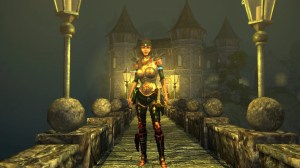Players will soon be able to explore the Magic: The Gathering multiverse in a brand new way via Magic: Legends, the free-to-play action RPG developed by Cryptic Studios and published by Perfect World Entertainment. With the project approaching open beta on March 23rd, the studios behind it invited ComicBook.com and other outlets to try out an early build of the game and see how Magic: The Gathering translates to an action RPG video game. At first glance, the game appears to be what you’d expect based on the genre. However, It quickly becomes apparent that Cryptic Studios has found creative ways to harness the essence of Magic — not the mythology alone but also the card game’s mechanics — in some unique and exciting ways.
Videos by ComicBook.com
In Magic: Legends, players take control of a Planeswalker and travel the vast multiverse established in Wizards of the Coast‘s seminal card game. Players can choose from five Planewalker classes, each rooted in a different mana color from Magic‘s color wheel. Necromancers harness black mana while Mind Mages use blue. Geomancers are red, Beast Callers are green, and Sanctifiers are white. Each of these classes has distinct primary, secondary, and ultimate powers.

It sounds like standard stuff thus far, but then you build a deck. Players will start the game with a certain number of spell cards, taken straight from the 20,000+ cards available in the TCG game, and collect more as they play the game. These cards can summon creatures, deal damage, or offer buffs and come in all five colors from the wheel. By the time players finish the first act of the game, they’ll have their first mono-colored deck. As they collect more cards of various colors, they can combine them to build unique decks suited for different builds and situations.
Interestingly, there’s no restriction put on the cards that the different Planeswalker classes can use. A Necromancer class planeswalker can use cards from black’s “enemy” colors, white and green, without penalty. Certain kinds of cards will synergize better with certain classes’ innate abilities — the Necromancer’s primary ability summons skeletons, making cards that summon and buff minions a natural fit — but there are no firm limitations.
The influence of deckbuilding doesn’t end with your character loadout. In many online RPGs, players determine a set rotation in which they activate the predetermined best powers in the best possible order. Lead with an area-of-effect nuke to soften the mobs up, crack a buff, spam another power to clear most of the leftovers out, et cetera. That’s more difficult in Magic: Legends. While a Planeswalker’s primary and secondary powers are always available, only a few spells from your deck are available in hand and therefore usable at a given time. You’ll draw more spells over time as you cast them, but you can’t depend on hotkey muscle memory here if you want to get the most out of them. Players will have to assess what’s available quickly — as well as their mana cost, deducted from the player’s mana bar — to decide the best order and timing to cast them.
Admittedly, being thrown into the deep end with a leveled-up Necromancer and a fleshed-out Boros (red/white) deck made those judgments challenging during the preview event. Still, it’s easy to see where slowly building up your deck would breed closer familiarity with it. It also brings a familiar Magic tension to the game, the choice between consistency, speed, and power. These spells’ mana costs mean you can’t unload them all at once. Players can cast cheap spells faster, while high-impact cards play more slowly. Do you load up on power cards or make a deck you can unload quickly?

Players also have to consider whether it’s worth it to play a few extra creature cards as redundancy to make sure they always have a friend to summon or if they’d prefer to include more buffs or damage spells. And that’s not even taking into consideration the artifacts players can equip to alter and enhance the effects of certain cards, like causing all “summon goblin” spells also to let loose explosives when cast.
Players aren’t limited to one deck either. They can brew many and choose the best one for any given situation. Something players will notice is that enemies have mana symbols next to their display names. The merfolk and drakes in this playthrough often had the blue mana symbol. That means that spells from blue’s enemy colors (red and green) deal extra damage against them. The developers say that the damage boost won’t be something players leveling up in the early game will worry much about, but fully expect players to build specialized decks for more challenging late and end-game missions based on what enemies they expect to face. Magic: Legends is hardly the first game to encourage players to customize their loadouts to the challenge at hand. Still, in Magic: The Gathering context, it’s almost like Cryptic managed to replicate the “metagame,” or the way players choose which cards to put in their Magic: The Gathering decks based partly on which decks they expect to face.
At this point, Magic: Legends is still an early build, and there are some bugs. Some quest markers were glitchy, and the second mission restarted as it neared completion, but the developers say these are known issues they’re working on addressing. One subtler struggle is keeping track of enemies. Playing the creature-dependent Necromancer meant that there were always lots of creatures on screen. With every class having access to creature spells, one imagines things would get even more crowded in multiplayer. While ally creatures have bright blue semicircles attached to them, they still manage to overwhelm the more subtly colored enemies, who would often blend into the background. But again, this is an early build, and the developers say visibility is still something they’re working on perfecting.
Cryptic is taking an intriguing approach to Magic: Legends. While the most basic aspects of the game will be familiar to ARPG fans — point, click, kill, loot — the developers are injecting a distinct Magic: The Gathering flavor into the game’s core as well as its surface veneer. If you’re dedicated to either Magic’s mythology or gameplay or a fan of ARPGs looking for a game that puts some new tweaks on the formula, Magic Legends‘ beta is likely worthy of your attention.
Magic: Legends goes into open beta on March 23rd. You can check out all of our previous coverage of the upcoming video game right here.








